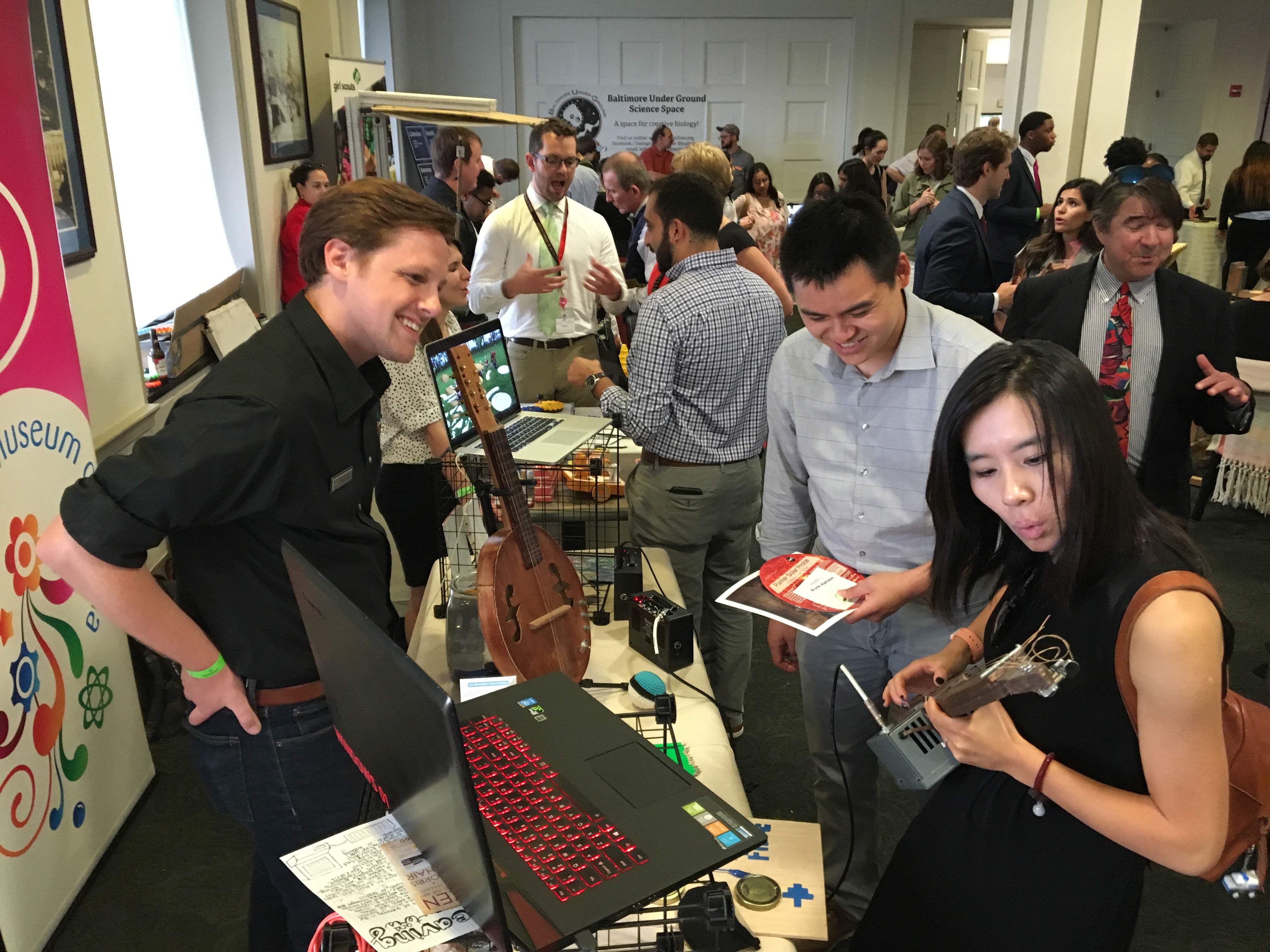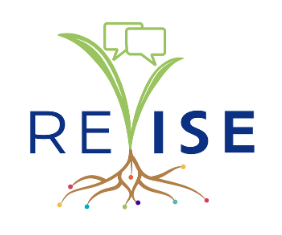
June 26th, 2018
Earlier this month, here at the Center for Advancement of Informal Science Education (CAISE), we celebrated the National Week of Making June 11-17. Jamie Bell, CAISE Project Director, attended the Capitol Hill Maker Faire, an event showcasing a selection of maker projects happening across the U.S., and informal science education (ISE) institutions were well-represented, with exhibitors from the New York Hall of Science; Museum of Science, Boston; Science Museum of Virginia; Children’s Museum of Pittsburgh; and the K.I.D. Museum in Montgomery County, MD among others. The event concluded a day of panel discussions with leaders of the maker movement discussing its impact on the U.S. economy, education, and community development. The National Week of Making is hosted by the Nation of Makers along with the Institute of Museum and Library Services (IMLS) and in collaboration with the Congressional Maker Caucus.
Photo: At the 2018 Capitol Hill Maker Faire, a guest tries out an electric “guitar” presented by “The Mix” at the Science Museum of Virginia.
Dig into the many resources on InformalScience.org
Our goal at CAISE is collect, curate, and create resources to keep the informal science education field knowledgeable about the breadth of work happening around the U.S. In CAISE’s 2017 Year in Informal STEM Education, a report tracking notable publications, events and trends over the year, we documented several key making and tinkering resources including peer-reviewed articles, practical guides, conferences and presentations, and more (slides 8-10). Currently, there are 153 project descriptions cataloged on InformalScience.org and a 2016 Knowledge Base article on Making and Tinkering Programs that offers a synthesis, as well as new directions in research and evaluation. Below, we’ve pulled a selection of 15 current National Science Foundation (NSF) making and tinkering projects, most of which are funded through the Advancing Informal STEM Learning (AISL) program. Enjoy!
-
Investigating STEM Literacies In MakerSpaces (STEMLiMS) is generating new knowledge on how participants in makerspaces: pose and solve problems; identify, organize and integrate information from different sources; integrate information of different kinds (visual, quantitative, and verbal); and share ideas, knowledge and work with others. From Eli Tucker-Raymond and Brian Gravel at TERC. Read their recent blog for CAISE here.
-
Increasing Learning and Efficacy About Emerging Technologies Through Transmedia Engagement By The Public In Science-in-Society Activities is using the interactive, engaging nature of digital narrative and hands-on maker activities to invite deeper conversations about questions of scientific innovation and responsibility around issues such as issues like like synthetic biology, robotics, genetics and machine learning. The project builds on themes of human creativity, societal responsibility and scientific ethics as first presented in Mary Shelley’s classic novel Frankenstein. From Edward Finn, Steve Gano, Ruth Wylie, Rae Ostman, and David Guston at Arizona State University.
-
The 2016 Math in the Making conference gathered researchers and practitioners from informal mathematics education and the making and tinkering movement to collaboratively generate approaches to integrating mathematics in making and design environments and programs. The workshop produced several resources for the field, available on their website. From Andee Rubin, TERC and Scott Pattison, Institute for Learning Innovation.
-
Culturally Responsive Making: Developing High-Low Tech Maker Activities In Local And Mobile Spaces For Supporting American Indian Youth is working with Indigenous communities in Arizona and Utah to leverage heritage craft practices, Indigenous technologies, and a mixture of high-low tech tools and materials to expand the range of available maker activities and broaden our definitions of making. From Bryan Brayboy, Arizona State University; Yasmin Kafai, University of Pennsylvania; Kristin Searle and Breanne Litts, Utah State University.
-
Remake Making: Understanding Adoption and Adaption of Facilitated Making in Libraries is deliver and improve a constructivist professional development program for library staff that work with youth in makerspaces, as effective facilitation for learning, like that required in makerspaces, is a relatively new facet of librarianship that is not a consistent part of librarian education. From Thomas Akiva, Leanne Bowler, and Kevin Crowley at the University of Pittsburgh, and Peter Wardrip, Children’s Museum of Pittsburgh.
-
Mobile Makerspaces for Children’s Hospital Patients: Exploring Impact on Patients’ Agency, Creative STEM Problem Solving and Physical Well-Being seeks to discover the education and health impacts of mobile makerspaces on chronically ill patients, and build knowledge around makerspace implementation in hospital settings. From Gokul Krishnan and Steven Schneider, WestEd.
-
Sustaining and Expanding Mobile Making in Underserved Communities is innovating on and expanding a pilot of the Mobile Making program with the goal of developing a sustainable, regional model for serving underserved, middle-school aged youth in 12 after-school programs in the San Diego region. From Edward Price and Charles De Leone, at California State University San Marcos.
-
Advancing Early STEM Learning Opportunities through Tinkering and Reflection is investigating how reflective interactions between parents and children (ages 6-8) during tinkering activities at the Tinkering Lab exhibit at Chicago Children’s Museum ultimately impact child engagement in STEM. From David Uttal, Northwestern University; Tsivia Cohen, Chicago Children’s Museum; and Catherine Haden and Perla Gamez, Loyola University of Chicago.
-
Engaging Parents as Makers to Build Capacity for Community-Based Making is taking a community psychology approach to building knowledge about how parents with little or no prior experience with making choose to engage with with, contribute to, and learn from maker programming. From Katherine McMillan, David Wells, and Susan Letourneau at the New York Hall of Science.
-
Two projects from Angie Calabrese Barton and Edna Tan at Michigan State University investigate the experiences of underrepresented youth and the role of identity in making.
-
Equitably Consequential Making Among Youth From Historically Marginalized Communities. Also with Scott Calabrese Barton.
-
Making for Change: Becoming Community Engineering Experts Through Makerspaces and Youth Ethnography. Read their recent blog for CAISE here.
-
-
Making as a Strategy for Afterschool STEM Learning is a report summarizing findings from a research-practice partnership between University of Washington, Exploratorium, Techbridge Girls, Discovery Cube, Community Science Workshop Network (a project of the Research+Practice Collaboratory). The report connects making to socio-emotional and youth development goals, key program elements that engage historically marginalized youth, and staff development needs.
-
Broadening Participation in STEM through Transdisciplinary Youth Development Activities aims to drive and transform the next generation of broadening participation efforts targeting teen-aged youth from communities historically underrepresented in STEM fields by investigating out-of-school time programs that integrate the arts, sciences, computer science, and other disciplines. From Bronwyn Bevan and Philip Bell, University of Washington; Kylie Peppler, Indiana University; Elisabeth Soep of Youth Radio in Oakland, CA; and Lynn Scarff, formerly of Science Gallery Dublin. This is a Science Learning+ project, a collaboration between NSF and the UK-based Wellcome Trust.
-
Making in the Colonias: Motivating STEM Participation through a Making as Micro-Manufacturing Model is testing the feasibility of integrating making concepts with real world micro-manufacturing engineering principles within the context of intense, multi-year team apprenticeship experiences for high school students. From Francis Quek, Sharon Lynn Chu, Malini Natarajarathinam, and Mathew Kuttolamadom, Texas A&M University.
-
The Design and Engineering of Scientific Instrumentation as a Pathway for Introducing Making into High School Science Classrooms is testing an approach to bringing making from primarily informal out-of-school contexts into formal science classrooms with a partnership between the NSF AISL and Innovative Technology Experiences for Students and Teachers (ITEST) programs. From David Uttal and Kemi Jona, Northwestern University.
-
A Networked Improvement Community for Broadening the Participation of Black and Latino Youth in Computational Careers is working to establish a national Networked Improvement Community (NIC) of makerspaces and fab labs serving Black and Latino high school students and specializing in computational making programs. From Margaret Honey, Katherine McMillan, Paul LeMahieu, Andres Henriquez, New York Hall of Science. This project is funded by NSF INCLUDES (Inclusion Across the Nation of Communities of Learners of Underrepresented Discoverers in Engineering and Science), a foundation-wide program that uses a collective impact approach in order to broaden participation in STEM at the national scale.
